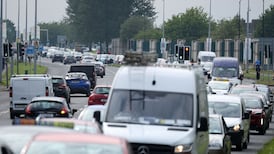Every regional authority would tell you it has a town that is a prime candidate for the designation "growth gateway". But in advance of the announcement of the designations next December, there are key indicators already visible, which rule some towns and cities in and others out. The criteria include access to energy, high-speed communications, an educated and available workforce, a quality environment, roads, rail and affordable housing.
The following is a potted guide to each region's suitability:
The South
Strengths: Cork city is set to remain the "growth engine" of Cork and south Kerry. It has good air and sea access, good energy connections, rail, education and an improving road infrastructure. It has been successful in attracting foreign direct investment in the pharmachemical and high-technology industries.
Weaknesses: The Spatial Study has found Cork is lagging behind Galway in terms of perception as a desirable place to live and raise a family. Car congestion in Cork city is a problem. Killarney and Tralee suffer from the distance to the major urban centres of Limerick and Cork.
Growth scenario: Future public transport routes could dictate where development will take place. A study, Moving Cork Transport Beyond 2000, lays particular emphasis on a suburban rail network and it and the Strategic Area Plan recommend upgrading of stations, track and rolling stock. Iarnrod Eireann is studying proposals to upgrade the Cork-Cobh line.
A suburban service between Mallow and Cobh and the reopening of the Midleton and Youghal service would bring a large area of east Cork into the travel-to-work area of the city.
The Dublin-Cork road is to be completely upgraded to motorway standard over the next five years, and the upgrading of the N22 between Cork city and Tralee via Killarney is planned. The rail line from Mallow to Tralee is also to be upgraded, and Killarney and Tralee may be targeted as lesser growth centres.
The Mid-West
Strengths: Centring on Limerick city, the area is emerging as a leading contender for designation as a growth gateway under the National Spatial Strategy.
With good educational facilities, energy connections, potential rail suburban services and Shannon Airport, the region already has much of the infrastructure needed to promote growth. It also has a good hinterland in environmental terms, places where high-calibre graduates may be inclined to settle with families, in turn luring foreign direct foreign investment.
The prospects for opening suburban services on existing rail routes, whether currently closed or not, are excellent.
The mid-west is well served by third-level educational facilities, with the University of Limerick and the Limerick Institute of Technology. The international airport at Shannon is close by and, while access is currently poor, a link to the Ennis rail line or a new light rail system through Shannon town are under consideration.
Access to high-speed broadband communications is good, and Ennis is the designated "information age town".
Weakness: In terms of the quality of the environment the inner-city areas of Limerick are perceived as a minus, but the availability of the Shannon estuary and the proximity of Lough Derg and the Burren can mitigate that.
Growth scenario: The region has the ability to develop as a counterbalance to the growth of Galway, delivering growth through secondary centres such as Ennis and Gort through Loughrea.
According to the Fitzpatrick report on spatial development, while the main drivers of growth are likely to be Limerick, Shannon and Ennis, retail turnover in small and medium-sized towns is already escalating and could reinforce the potential of these towns to spread the benefits of growth.
As urban sprawl develops in Galway, the Limerick-Galway axis is likely to link up in the coming decade. The effect of this would be to create a combined growth pole on the western seaboard which could to some extent counterbalance the drift of population towards the east coast. It could also attract a workforce from a wide spread of the midlands.
The West
Strengths: Galway emerged in the last decade as one of the Republic's preferred places to live and work, with a perception of a high quality of life and a good environment in which to raise children. Major employers in the desired high-tech as well as traditional industries are represented.
Castlebar suggests itself as a secondary growth centre, part of the outer ring around Athlone/Galway. It is also a seat of the Galway/Mayo Institute of Technology. Roscommon town may achieve secondary development while Strokestown and Boyle are firmly on the tourist map.
Weaknesses: Galway is rapidly becoming congested, and while much good urban redevelopment has taken place it is developing its own suburban sprawl in the direction of Dublin. Access roads to Knock Airport desperately need upgrading. Castlebar has a poor rail service but this is being improved.
Possible growth scenario: Galway to remain the growth gateway for the region. Possible commuter rail service to the city from Oranmore to be developed. Future development along the LoughreaGort-Ennis axis to form a "growth pole" along the western seaboard. Secondary growth centres at Castlebar and Ballinasloe.
The North-West
Strengths: Perceived to offer a good quality of life in a near-unspoilt environment. The region benefits from EU Peace Programme, Interreg and International Fund for Ireland investment. It is part of the Border, Midlands and Western Region which is targeted for 50 per cent of all new greenfield industrial investment by the Government. It has an institute of technology at Letterkenny.
Weaknesses: A poor-quality rail service to Sligo. National road routes to Sligo, and Cavan/Donegal are not included in the designation of "key strategic corridors". There is concern over the availability of electricity infrastructure. It has no access to natural gas although a campaign is under way to secure a spur from the Corrib field pipeline.
Possible growth scenario: The comparatively low population has provoked an examination among planners of the meaning of "balanced regional development". As the population does not justify attempts to get a major "world-player" corporation such as Intel, is it right that the State should plan for such a scenario?
People can live in the north-west as well as they do in Dublin, on less money because housing is less expensive, and some planners are asking if in fact the balance is in that quality of life.
Letterkenny suggests itself as an "outer" centre based on cross-Border traffic with Derry. In the absence of a cross-Border strategy, growth would be in the existing centres of Sligo, Cavan and increasingly Carrick-on-Shannon.
The North-East
Strengths: It has excellent and improving public transport facilities, excellent high-speed broadband communications, energy in terms of gas and electricity, and roads.
Long promoted as the "economic corridor" between Dublin and Belfast, the National Development Plan envisages a motorway from Dublin to the Border, much of which is already in place.
Cos Louth and Monaghan benefit from cross-Border development incentives including Interreg, the EU Peace Programme, the International Funds for Ireland and a special Peace Programme in the National Development Plan.
In European terms, however, the Dublin-Belfast corridor is the significant development zone on the island. It has attracted a good share of Ireland's foreign direct investment from high-tech industries.
Weaknesses: Urban sprawl from Dublin threatens to destroy the strategic value of the investment in motorways and, to a lesser extent, the inter-urban train service. Commuting to Dublin from as far away as Co Cavan causes commuter traffic to clog these arteries. There is no rail link to Navan, while the National Development Plan does not envisage strategic road schemes for the N2 and N3 routes through Meath and Monaghan. Growth scenario: The Dublin-Belfast corridor will continue to be the growth engine for the region, with expansion in Drogheda and, to a lesser extent, in Dundalk. The Strategic Planning Guidelines for the Greater Dublin Area designate Balbriggan as a primary growth centre, while Rush/ Lusk is to be a secondary centre.
A new city of about 80,000 people is planned for Navan, and a new rail link is likely to open up to Dublin. Secondary growth likely at Kells. The urban sprawl from Dublin is likely to continue to eat away at Co Meath.
The South-East
Strengths: The largest urban centre in the region is Waterford, which embraces a population of about 90,000 in the city and its "journey-to-work area". Waterford has mainline rail links with Clonmel, Kilkenny/Carlow, New Ross and Rosslare. Considerable scope for suburban development exists along these lines.
The region also contains the Europort at Rosslare, and over the next five years a new M9 Dublin-Waterford road will be developed to motorway standard. It has good electricity and natural gas supplies, and there are institutes of technology at Clonmel and Waterford.
Weaknesses: The railway serving Waterford is vastly underutilised, and there is apparently no demand for plans to upgrade or re-signal it. The Suir and its single road crossing in Waterford city on the N9/25 also lead to considerable traffic congestion. The regional airport requires investment.
Growth scenario:
Industrial development is planned around Carlow, Kilkenny and Waterford. Development of heritage/ tourism industries in Kilkenny and tourism/aquaculture throughout the region is planned.
The Midlands
Strengths: Major road and rail routes offer access to all the Republic's cities. There is good or improving environmental quality around the Shannon and its lakes.
Weaknesses: The long-term economic impact of tax-based developments, which encourage housing developments in advance of a critical employment pool, such as apartment developments in remote areas of the north Shannon basin, is difficult to quantify.
Possible growth scenario:
The low population coupled with the spread of electricity-generating stations, formerly powered by peat, has led to a debate on the possibility of maintaining the region as an electricity provider powered in future by wind farms. The east of the region is likely to continue to be affected by Dublin's urban sprawl.
Athlone is likely to be the growth engine. If developed to city status, it could effect counter-commuting from both Galway and Dublin.







